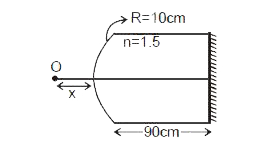The object shown at the right is taken out in the sun and rotated. The different shadows formed are observed. Mark the picture which cannot be the shadow of this object.





Shadow shown in alternative (c) has a Curved face while the object does not have a curved surface.
Topper's Solved these Questions
- LIGHTBOOK - S CHAND IIT JEE FOUNDATIONCHAPTER - LIGHTEXERCISE - SELF ASSESSMENT SHEET -4
24 Videos
- FORCE AND PRESSURE BOOK - S CHAND IIT JEE FOUNDATIONCHAPTER - FORCE AND PRESSURE EXERCISE - Self Assessment Sheet
11 Videos
- MAGNETISMBOOK - S CHAND IIT JEE FOUNDATIONCHAPTER - MAGNETISMEXERCISE - SELF ASSESSMENT SHEET-6
31 Videos
Similar Questions
A clever student has used the concept of formation of shadow to determine the height of a long pole (OA). There was an electric bulb at the top of the vertical pole. The student placed an object of length 1 m at a height of 2 m from the ground as shown in the figure. The size of the shadow formed on the ground is 2 m. Determine the length of the pole.

View Solution
If a particle is seen through layers of parallel glass slabs of different refractive index as shown in figure. Where μ0 is the medium of the observer. If the object has velocity v towarsd observer at this instant along the line joining object and observer then, which of the following correctly represent the velocity of the object as seen by observer?
View Solution
Knowledge Check

If a particle is seen through layers of parallel glass slabs of different refractive index as shown in figure. Where μ0 is the medium of the observer. If the object has velocity v towarsd observer at this instant along the line joining object and observer then, which of the following correctly represent the velocity of the object as seen by observer?Avapp=Vm3/μ0Bvapp=vμ1/μ0Cvapp=vμ1/μ0+vμ2/μ0+vμ3/μ0Dvapp=vThe property of the image formed by a plane mirror, due to which the left and right sides of the image are the reverse of the left and right sides of the object, is called _______
AReflectionBrefractionCLateral inversionDIncidenceA point object is moving along principal axis of concave mirror with uniform velocity towards pole. Initially the object is at infinite distance from pole right side of the mirror as shown. Before the object collides with mirror, the number of times a which the distance between object and its image is 40cm are.
 .Aone timeBtwo timesCthree timesDDate insufficient
.Aone timeBtwo timesCthree timesDDate insufficient

The solid so formed by joining unit cubes is rotated to obtain different positions, which of these cannot be the shape after it has turned?

View Solution
Why do these objects form shadows?
View SolutionFind out the value of x for which the image is formed on the object itself.

View SolutionObserve.
Study the given figure. Determine the position, size and nature of images formed for different posidons of an object with the help of ray diagrams.

View SolutionDistance between a fixed linear object and a fixed screen is 40cm .A thin convex lens of focal length 10cm is kept between object and screen such that object is perpendicular to the principal axis of lens as shown in figure.It is observed that for two different positions of lens images are formed on the screen.If size of images for the two different positions of lens are 9cm and 4cm then size of object in cm is......
View Solution
